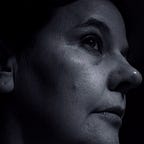Week 51 - Minimalism is a verb
20 December, 2020
Black and white minimalism is probably the starkest photographic genre of them all. Not only have we stripped away all the colours in the photo, but we also have so few elements left to tell a story with.
Although I am absolutely in love with the clean lines of black and white minimalism, it took me quite a while to get it right. My photos were either too busy or full of greys - making my photo look 'muddy'.
I then realized that minimalism should be approached more like a sculpture than a photograph. You create your scene and then remove as much as you can. Every single thing that stays must have a bloody good reason to be there.
It has to help tell the story of the photo. From the shadow on the wall to the glint of light on the handle to the amount of umbrella material shown.
Thinking about minimalism in photography of course made me think of minimalism in life. It does seem to be the fashion these days, no?
Marie Kondo became famous for advising people on how to get rid of junk, web and product design is getter 'flatter' and cleaner by the day and The Minimalists made an entire career out of ... being minimalists.
Why has minimalism become so popular now? I think it is because our lives have become so full of junk.
Email inboxes, supermarkets filled with amazing things, over the top packaging, unnecessary gifts and goody bags and other possessions. They pile up as quickly as you can say ' free gift' or even 'retail therapy'.
All these things however do not seem to make us happy.
Just as we need lots of white space in text to properly read and understand it, we seem to need space in our lives too.
We enjoy seeing the kitchen clean and tidy after a good cleanup. It is a delight to heave that bag of old clothes into the clothes recycle bin. Bathrooms have to be spotless and bright, hotel lobbies are appreciated for their cool marble floors and high ceilings with maybe one flower arrangement as decoration.
Have a look around you. Most of the spaces that we enjoy living and working in are (usually) quite uncluttered. Beyond our own personal space requirements, we seem to need a further margin of empty space to life and breathe in.
Dr. Huberman, a neurobiologist, says that we are more relaxed outdoors looking at a panoramic landscape than indoors. There we focus on the things in front of us - such as a phone or television.
"So it’s fair to say that what you see and how you view the world, literally, has an incredible impact on your state of mind".
So if empty open spaces make us feel good, it is probably a good idea to go for that minimalist vibe in our indoors spaces too. But it doesn't really work like that, does it?
I find myself to be a constant minimalist. I am good at throwing out the junk and like my space clean and tidy.
And yet, the flotsam and jetsam of life keep on washing up into my home, my cell phone, my backpack, the email box. The messy drawer in the kitchen always goes back to its default state - usually at warp speed.
Why does this happen? We know that unnecessary stuff complicates life and it is a chore to get rid of it.
So how come we constantly find ourselves deleting old photos and clearing out the cupboards?
It is because minimalism is a verb.
Just like I had to learn to approach minimalist photography as a sculpture and to remove the unwanted bits, I realized that this is the same with my life.
I have to either make time to go and look for junk and get rid of it. Or identify junk as soon as I see it and not allow it to come near me. A combination of these two is probably the best way to stay a minimalist.
One has to constantly keep your eyes open.
Only the things that have a bloody good reason, that helps tell your story, are allowed to stay.
Read some of the other life lessons that I have learned during my 52Frames - 2020 project at my Medium page.
